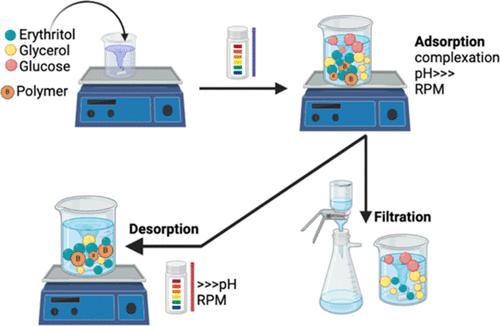当前位置:
X-MOL 学术
›
Ind. Eng. Chem. Res.
›
论文详情
Our official English website, www.x-mol.net, welcomes your
feedback! (Note: you will need to create a separate account there.)
Assessment of the Recovery of Erythritol Using Boronic Acid Polymers
Industrial & Engineering Chemistry Research ( IF 3.8 ) Pub Date : 2024-11-18 , DOI: 10.1021/acs.iecr.4c01224 Laura V. Daza-Serna, Valérie Toussaint, Astrid R. Mach-Aigner, Robert L. Mach, Philipp Kessler, Stephanie Bachmann, Ann-Christin Pöppler, Anton Friedl, Irina Delidovich
Industrial & Engineering Chemistry Research ( IF 3.8 ) Pub Date : 2024-11-18 , DOI: 10.1021/acs.iecr.4c01224 Laura V. Daza-Serna, Valérie Toussaint, Astrid R. Mach-Aigner, Robert L. Mach, Philipp Kessler, Stephanie Bachmann, Ann-Christin Pöppler, Anton Friedl, Irina Delidovich

|
The development and assessment of novel materials and technologies in the downstream stages is one of the main challenges for the technological transition toward more sustainable and circular processes. Erythritol is in high demand as a low-calorie sweetener as well as a substrate in the pharmaceutical and cosmetic industries. Nowadays, erythritol is produced biotechnologically, and its recovery from complex cultivation broths poses a challenge. In this study, the recovery of erythritol from a mixture with glycerol and glucose using the adsorption of erythritol onto boronic acid polymers was evaluated. p-vinylphenylboronic acid was cross-linked by divinylbenzene; the polymer was characterized and used as an adsorbent. The adsorption parameters, such as NaOH-to-polyols ratio and mass of polymer, were optimized. Under the best conditions, 71% of the initial mass of erythritol was adsorbed, equivalent to a load of 198 mg of erythritol/g of polymer. Chemical adsorption owing to complexation with phenylboronate moieties and physical adsorption due to retention of the gel-type polymer were studied. Highly selective erythritol uptake owing to complexation with a separation factor of up to 4 was observed, though the contribution of the physical adsorption was responsible for a decrease in overall selectivity. The desorption strategies included washing and a desorption with H2SO4, resulting in the recovery of 59% of the initial mass of erythritol. Shrinkage of the gel-type polymer under acidic conditions was the major challenge in the recovery of the polyols during the desorption. Solid-state 11B and 13C NMR spectroscopy were used to examine the adsorption and desorption steps.
中文翻译:

使用硼酸聚合物评估赤藓糖醇的回收率
在下游阶段开发和评估新型材料和技术是向更可持续和循环工艺过渡的主要挑战之一。赤藓糖醇作为一种低热量甜味剂以及制药和化妆品行业的底物,需求量很大。如今,赤藓糖醇是通过生物技术生产的,从复杂的培养液中回收赤藓糖醇是一项挑战。在这项研究中,利用赤藓糖醇吸附到硼酸聚合物上,评估了赤藓糖醇从甘油和葡萄糖的混合物中回收率。对乙烯基苯硼酸经二乙烯基苯交联;对聚合物进行表征并用作吸附剂。对吸附参数,如 NaOH 与多元醇的比例和聚合物的质量进行了优化。在最佳条件下,赤藓糖醇初始质量的 71% 被吸附,相当于负载量为 198 mg 赤藓糖醇/g 聚合物。研究了与苯硼酸盐部分络合引起的化学吸附和由于凝胶型聚合物保留引起的物理吸附。观察到由于分离因子高达 4 的络合而导致的高选择性赤藓糖醇摄取,尽管物理吸附的贡献是导致整体选择性降低的原因。解吸策略包括洗涤和用 H2SO4 解吸,从而回收了 59% 的初始质量的赤藓糖醇。凝胶型聚合物在酸性条件下的收缩是解吸过程中多元醇回收的主要挑战。固体 11B 和 13C NMR 波谱用于检查吸附和解吸步骤。
更新日期:2024-11-18
中文翻译:

使用硼酸聚合物评估赤藓糖醇的回收率
在下游阶段开发和评估新型材料和技术是向更可持续和循环工艺过渡的主要挑战之一。赤藓糖醇作为一种低热量甜味剂以及制药和化妆品行业的底物,需求量很大。如今,赤藓糖醇是通过生物技术生产的,从复杂的培养液中回收赤藓糖醇是一项挑战。在这项研究中,利用赤藓糖醇吸附到硼酸聚合物上,评估了赤藓糖醇从甘油和葡萄糖的混合物中回收率。对乙烯基苯硼酸经二乙烯基苯交联;对聚合物进行表征并用作吸附剂。对吸附参数,如 NaOH 与多元醇的比例和聚合物的质量进行了优化。在最佳条件下,赤藓糖醇初始质量的 71% 被吸附,相当于负载量为 198 mg 赤藓糖醇/g 聚合物。研究了与苯硼酸盐部分络合引起的化学吸附和由于凝胶型聚合物保留引起的物理吸附。观察到由于分离因子高达 4 的络合而导致的高选择性赤藓糖醇摄取,尽管物理吸附的贡献是导致整体选择性降低的原因。解吸策略包括洗涤和用 H2SO4 解吸,从而回收了 59% 的初始质量的赤藓糖醇。凝胶型聚合物在酸性条件下的收缩是解吸过程中多元醇回收的主要挑战。固体 11B 和 13C NMR 波谱用于检查吸附和解吸步骤。


















































 京公网安备 11010802027423号
京公网安备 11010802027423号